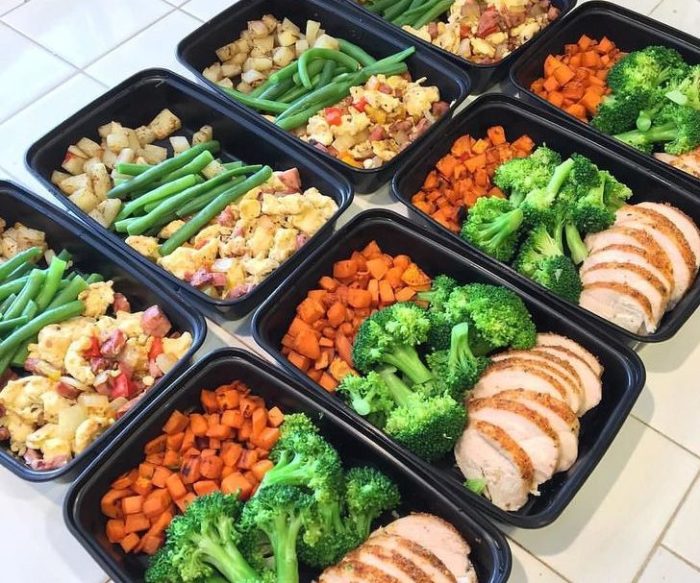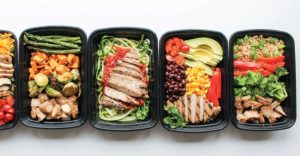
Tired of pre-packaged sadness masquerading as “healthy”? Let’s ditch the diet doldrums and embrace the glorious world of healthy meal prepping for fitness! Imagine a week where your meals are not only nutritious but also exciting, a culinary adventure fueled by your fitness goals. Forget soggy salads and flavorless chicken – we’re talking gourmet goodness that builds muscle, blasts fat, and leaves you feeling like a superhero (with a slightly less-intense workout).
This guide isn’t just about throwing some chicken and broccoli in a Tupperware; it’s a strategic approach to fueling your body for optimal performance. We’ll unravel the mysteries of macronutrients, conquer the art of batch cooking, and unleash your inner culinary ninja with delicious recipes that will have you saying goodbye to takeout forever (or at least until Friday night pizza).
Get ready to transform your relationship with food and your fitness journey!
Defining “Healthy Meal Prep for Fitness”
Let’s face it, achieving your fitness goals is a marathon, not a sprint (unless you’re training for sprints, in which case, good luck!). And like any marathon, proper fuel is essential. Healthy meal prep for fitness isn’t just about eating salads; it’s about strategically planning your meals to optimize your performance, recovery, and overall well-being. It’s the secret weapon for those who want to see real, lasting results.Healthy meal prep for fitness is the practice of preparing nutritious meals in advance to support your fitness goals.
It’s about taking control of your nutrition, ensuring you consistently consume the right balance of macronutrients (protein, carbohydrates, and fats) and micronutrients (vitamins and minerals) to fuel your workouts, build muscle, and recover effectively. Forget those post-workout cravings for questionable convenience food; meal prepping gives you the power to make healthy choices, even when you’re short on time.
Key Components of a Healthy Meal Prep Plan for Fitness
A successful meal prep plan hinges on several key elements. It’s not just about throwing some chicken and broccoli in a container. Consider these crucial components:
- Macronutrient Balance: Understanding your individual macronutrient needs (protein, carbohydrates, and fats) based on your fitness goals and activity level is paramount. A higher protein intake is generally recommended for muscle growth and repair, while carbohydrates provide energy for workouts. Healthy fats support hormone production and overall health.
- Prioritization of Whole Foods: Focus on unprocessed, whole foods like lean proteins (chicken breast, fish, tofu), complex carbohydrates (brown rice, quinoa, sweet potatoes), and healthy fats (avocado, nuts, olive oil). These provide sustained energy and essential nutrients.
- Portion Control: Knowing your appropriate portion sizes is crucial for managing calorie intake and achieving your fitness goals. Using food scales and measuring cups can be incredibly helpful in the beginning.
- Meal Timing: Consider the timing of your meals relative to your workouts. Pre-workout meals should provide readily available energy, while post-workout meals should focus on protein and carbohydrates for muscle recovery.
- Hydration: Don’t forget the importance of hydration! Water is essential for optimal bodily functions, especially during and after exercise. Aim for consistent water intake throughout the day.
Sample Weekly Meal Plan
This sample plan offers a flexible framework. Adjust portion sizes and specific foods to meet your individual needs and preferences. Remember to consult a registered dietitian or nutritionist for personalized guidance, especially if you have specific dietary needs or health conditions.
| Day | Meal | Description |
|---|---|---|
| Monday | Breakfast | Oatmeal with berries and nuts |
| Monday | Lunch | Grilled chicken salad with mixed greens, avocado, and a light vinaigrette |
| Monday | Dinner | Baked salmon with roasted vegetables (broccoli, carrots, sweet potatoes) |
| Tuesday | Breakfast | Greek yogurt with fruit and granola |
| Tuesday | Lunch | Leftover baked salmon and roasted vegetables |
| Tuesday | Dinner | Lentil soup with whole-wheat bread |
| Wednesday | Breakfast | Scrambled eggs with spinach and whole-wheat toast |
| Wednesday | Lunch | Chicken breast and brown rice |
| Wednesday | Dinner | Turkey meatballs with zucchini noodles |
| Thursday | Breakfast | Smoothie with protein powder, spinach, banana, and almond milk |
| Thursday | Lunch | Leftover turkey meatballs and zucchini noodles |
| Thursday | Dinner | Chicken stir-fry with brown rice |
| Friday | Breakfast | Whole-wheat pancakes with fruit and a small amount of maple syrup |
| Friday | Lunch | Tuna salad sandwich on whole-wheat bread |
| Friday | Dinner | Pizza with whole-wheat crust, lean protein, and lots of vegetables |
| Saturday | Breakfast | Breakfast burrito with scrambled eggs, black beans, salsa, and whole-wheat tortilla |
| Saturday | Lunch | Leftover pizza |
| Saturday | Dinner | Steak with sweet potato fries and a side salad |
| Sunday | Breakfast | Omelet with vegetables and cheese |
| Sunday | Lunch | Leftover steak and sweet potato fries |
| Sunday | Dinner | Chicken and vegetable skewers |
Remember, consistency is key! Even small, consistent changes in your diet can make a big difference in your fitness journey.
Macronutrient Balance for Fitness

Fueling your body for fitness isn’t just about eating; it’s about orchestrating a delicious symphony of macronutrients – carbohydrates, proteins, and fats – to hit the right notes for your fitness goals. Think of it as a culinary composition where each macronutrient plays a vital role in your performance, recovery, and overall well-being. Get the balance wrong, and your fitness journey might sound more like a cacophony than a concerto.Getting the macronutrient ratio right is crucial for maximizing your fitness results.
It’s like fine-tuning a sports car – you need the right blend of power (carbs), strength (protein), and lubrication (fats) to reach peak performance. Ignoring this balance can lead to sluggish workouts, slow recovery, and even hinder your progress.
Macronutrient Ratios for Different Fitness Goals
Different fitness goals require different macronutrient ratios. For muscle building, you’ll need a higher protein intake to support muscle growth and repair. Weight loss often involves a slightly lower carbohydrate intake to promote fat burning. Endurance athletes, on the other hand, may need more carbohydrates for sustained energy. Let’s explore some examples:
Example Meal Prep Recipes
Here are a few examples of meal prep recipes designed for various fitness goals, showcasing different macronutrient ratios. Remember, these are just starting points; adjust portion sizes and ingredients to fit your individual needs and preferences. Muscle Building:* Recipe: Chicken breast with brown rice and steamed broccoli. This provides a good balance of lean protein, complex carbohydrates for energy, and fiber-rich vegetables.
Macronutrient Ratio (approximate)
40% carbohydrates, 30% protein, 30% fats. Weight Loss:* Recipe: Salmon with quinoa and asparagus. Salmon provides healthy fats and protein, quinoa offers complex carbohydrates, and asparagus adds vitamins and fiber.
Macronutrient Ratio (approximate)
30% carbohydrates, 40% protein, 30% fats. Endurance:* Recipe: Oatmeal with berries and nuts. Oatmeal provides slow-releasing carbohydrates for sustained energy, berries add antioxidants, and nuts offer healthy fats.
Macronutrient Ratio (approximate)
50% carbohydrates, 25% protein, 25% fats.Remember, these are just examples, and individual needs vary greatly depending on factors like activity level, body composition, and individual metabolic rate.
Macronutrient Composition of Common Ingredients
Understanding the macronutrient content of common ingredients is key to successful meal prepping. This table provides a general overview; specific values can vary based on brand and preparation methods.
| Ingredient | Carbohydrates (g/100g) | Protein (g/100g) | Fat (g/100g) |
|---|---|---|---|
| Chicken Breast | 0 | 30 | 2 |
| Brown Rice | 77 | 7 | 2 |
| Salmon | 0 | 20 | 13 |
| Quinoa | 64 | 14 | 2 |
| Oatmeal | 66 | 13 | 7 |
Meal Prep Strategies and Techniques
Conquering the week’s meals doesn’t require a culinary degree or superhuman willpower; it just needs a smart strategy. Think of meal prepping as a preemptive strike against hunger-induced bad decisions – a delicious, muscle-building ambush against those office vending machines! This section will arm you with the techniques to become a meal prep master.Meal prepping isn’t a one-size-fits-all affair.
The best approach depends on your lifestyle, available time, and cooking skills (or lack thereof!). From the “batch cooking behemoth” to the “component connoisseur,” we’ll explore various methods to find your perfect fit.
Batch Cooking: The Efficient Approach
Batch cooking is your friend. It’s all about making large quantities of a single dish at once. Imagine a glorious pot of chicken and veggie stir-fry, enough to feed you for three days. The key is choosing recipes that hold up well after reheating and can be easily adapted for variety. For instance, that chicken stir-fry could become chicken salad sandwiches with a few tweaks.
This method saves considerable time and effort, perfect for those with busy schedules. The initial investment in time yields substantial returns throughout the week.
Individual Component Prep: The Customizable Method
This approach focuses on prepping individual components – proteins, grains, vegetables – separately. Think of it as building blocks for your meals. Roast a large tray of chicken breasts on Sunday, boil a batch of quinoa, and chop a mountain of vegetables. Then, throughout the week, you can mix and match these components to create a diverse range of meals.
This offers maximum flexibility and prevents meal boredom. For example, one day you might have chicken and quinoa with roasted broccoli, and the next, a chicken salad with mixed greens and your leftover quinoa.
Utilizing Pre-cut Vegetables: The Time-Saving Hack
Let’s be honest, chopping vegetables can be tedious. Pre-cut vegetables are a lifesaver for busy individuals. While they might cost a bit more, the time saved is often worth the investment, especially if you’re short on time or lack the enthusiasm for chopping. Look for options that are minimally processed and stored properly to maintain freshness and nutritional value.
A Week-Long Meal Prep Guide: Conquer Your Calendar
Planning is key! Before you even reach for your spatula, map out your meals for the week. Consider your schedule, dietary needs, and preferred meals. Then, create a shopping list based on your meal plan. This prevents impulse buys and ensures you have all the necessary ingredients.
- Sunday: The Prep DayDedicate a few hours on Sunday to grocery shopping and meal prep. This is your time to conquer the week’s culinary challenges.
- Cooking and PortioningPrepare your chosen dishes in large batches. Portion them into individual containers for easy grab-and-go meals throughout the week.
- Strategic StorageUtilize airtight containers to maintain freshness and prevent spills. Label each container with the contents and date to avoid any confusion.
- Refrigeration and FreezingStore your meals properly in the refrigerator or freezer, depending on their shelf life. Remember, freezing is your friend for longer-term storage.
- The Week AheadEnjoy your prepped meals throughout the week! Remember to reheat thoroughly before eating.
Leftover Liberation: Transforming Remnants into Culinary Gold
Leftovers are not the enemy; they’re an opportunity! That leftover roasted chicken can become a delicious chicken Caesar salad. Last night’s stir-fry can be transformed into a tasty omelet filling. Get creative! Don’t be afraid to experiment and find new ways to use your leftovers to prevent food waste and add variety to your meals. Think of leftovers as culinary LEGO bricks – endlessly recombinable to build delicious new creations.
Healthy Recipe Ideas
Let’s face it, eating healthy doesn’t have to be a punishment. These recipes are designed to fuel your fitness goals without sacrificing flavor or fun. Think of them as your secret weapon in the battle against bland, boring meals. Prepare to be amazed (and maybe a little bit full).
Chicken and Veggie Power Bowls
This vibrant bowl is a powerhouse of protein and nutrients, perfect for muscle building and recovery. Imagine a colorful explosion of textures and flavors in every bite.
Ingredients: 1.5 cups cooked chicken breast (cubed), 1 cup quinoa, 1 cup roasted broccoli florets, ½ cup roasted sweet potatoes (cubed), ½ cup cherry tomatoes (halved), ¼ cup crumbled feta cheese, 2 tablespoons olive oil, 1 tablespoon lemon juice, salt and pepper to taste.
Nutritional Benefits: High in protein, fiber, and vitamins. Excellent for muscle growth and repair, improved energy levels, and digestive health. Suitable for strength training, endurance training, and weight management goals.
Visual Representation: A deep bowl overflowing with vibrant colors. Tender chunks of chicken nestle amongst fluffy quinoa, bright green broccoli, and sweet orange sweet potatoes. Scattered cherry tomatoes add pops of red, while the creamy white feta cheese provides a salty counterpoint. A light drizzle of olive oil and lemon juice adds a glossy sheen.
Salmon with Roasted Asparagus and Brown Rice
This elegant and healthy meal is packed with omega-3 fatty acids, essential for reducing inflammation and boosting brain function. It’s the perfect post-workout meal to help your body recover.
Ingredients: 1 salmon fillet (6-8 oz), 1 bunch asparagus (trimmed), 1 cup brown rice, 1 tablespoon olive oil, 1 teaspoon lemon zest, salt and pepper to taste.
Nutritional Benefits: High in protein, omega-3 fatty acids, and fiber. Excellent for reducing inflammation, improving heart health, and boosting brain function. Suitable for all fitness goals, particularly those focused on recovery and overall health.
Visual Representation: A perfectly cooked salmon fillet, its skin glistening with a light sheen, sits atop a bed of tender, bright green roasted asparagus. Fluffy brown rice forms a gentle base, adding a touch of earthy warmth. The whole dish is subtly seasoned, allowing the natural flavors of the ingredients to shine.
Lentil Soup with Whole Wheat Bread
This hearty and comforting soup is a fantastic source of plant-based protein and fiber, keeping you full and satisfied for hours. It’s a great option for those seeking a vegetarian or vegan approach to fitness.
Ingredients: 1 cup brown or green lentils, 4 cups vegetable broth, 1 onion (chopped), 2 carrots (chopped), 2 celery stalks (chopped), 1 teaspoon cumin, ½ teaspoon turmeric, salt and pepper to taste, 2 slices whole wheat bread.
Nutritional Benefits: High in protein, fiber, and iron. Excellent for digestive health, weight management, and sustained energy levels. Suitable for vegetarians, vegans, and those following plant-based diets for fitness.
Visual Representation: A rustic bowl filled with a rich, vibrant lentil soup. The lentils are plump and tender, surrounded by soft pieces of onion, carrot, and celery. A hint of golden turmeric adds a warm glow to the soup. Two slices of hearty whole wheat bread sit beside the bowl, offering a satisfying contrast in texture.
Turkey and Avocado Wraps
These quick and easy wraps are perfect for a pre-workout snack or a light lunch. The healthy fats in the avocado will provide sustained energy.
Ingredients: 4 whole wheat tortillas, 4 oz sliced turkey breast, ½ avocado (mashed), ¼ cup shredded lettuce, ¼ cup chopped tomato, 1 tablespoon light ranch dressing (optional).
Nutritional Benefits: Moderate in protein and healthy fats. Provides sustained energy and essential nutrients. Suitable for those looking for a quick and easy pre-workout snack or light meal.
Visual Representation: Four vibrant green whole wheat tortillas wrapped around slices of lean turkey breast. Creamy avocado mash adds a rich green layer, while the bright red tomatoes and crisp lettuce provide pops of color and texture. A light drizzle of ranch dressing adds a creamy finish (optional).
Overnight Oats with Berries and Nuts
This make-ahead breakfast is a fantastic source of fiber and complex carbohydrates, providing sustained energy to fuel your workouts.
Ingredients: ½ cup rolled oats, 1 cup milk (dairy or non-dairy), ¼ cup berries (fresh or frozen), 1 tablespoon chia seeds, 1 tablespoon chopped nuts (almonds, walnuts, etc.), 1 teaspoon honey or maple syrup (optional).
Nutritional Benefits: High in fiber and complex carbohydrates. Provides sustained energy and essential nutrients. Suitable for all fitness goals, particularly those focused on endurance and weight management.
Visual Representation: A clear glass jar filled with creamy overnight oats. The oats are speckled with the vibrant colors of mixed berries, and the scattered chia seeds add a subtle texture. Chopped nuts provide a crunchy topping, and a drizzle of honey or maple syrup adds a touch of sweetness (optional).
Nutrition and Fitness Goals
Fueling your body for fitness is like choosing the right car for a road trip – a tiny Smart Car won’t cut it for a cross-country adventure, just as a diet designed for weight loss won’t necessarily build muscle. Nutritional needs shift dramatically depending on your fitness goals, making a one-size-fits-all approach as effective as a square peg in a round hole.Different fitness goals require different macronutrient ratios.
Weight loss typically involves a calorie deficit, often achieved by increasing protein intake to maintain muscle mass while reducing overall calories from carbohydrates and fats. Muscle gain, conversely, demands a calorie surplus with a higher protein intake to support muscle protein synthesis, along with sufficient carbohydrates for energy and fats for hormone production. Endurance training necessitates a focus on carbohydrate loading to replenish glycogen stores, crucial for sustained energy during prolonged exercise.
Nutritional Needs Based on Fitness Goals
The energy demands of different fitness goals vary greatly. Weight loss focuses on creating a calorie deficit to tap into stored fat reserves. Imagine your body as a bank account; to lose weight, you’re spending more calories than you deposit. Muscle gain, on the other hand, necessitates a calorie surplus, “depositing” more calories than you spend to fuel muscle growth.
Endurance athletes, like marathon runners, need a consistent supply of energy, akin to having a reliable ATM to withdraw funds for prolonged exertion. This requires a well-planned strategy to replenish glycogen stores, crucial for sustained performance. Failing to meet these specific energy requirements can lead to plateaus, injuries, and decreased performance.
Common Nutritional Pitfalls in Meal Prepping
Many common meal prepping pitfalls can sabotage even the most dedicated fitness plan. One frequent issue is relying too heavily on processed “healthy” foods. While marketed as convenient, many lack essential nutrients and are loaded with hidden sugars and sodium. Another pitfall is inadequate portion control, even with healthy meals. Pre-portioning meals helps prevent overeating, which can hinder weight loss or negatively impact other fitness goals.
Finally, neglecting the importance of micronutrients is a common mistake. Vitamins and minerals are crucial for overall health and performance, and a diet focused solely on macronutrients can leave you feeling depleted. A balanced meal prep plan considers the full nutritional spectrum.
Hydration and Supplementation
Proper hydration is often overlooked, but it’s as crucial as the food you eat. Dehydration impairs performance, reduces energy levels, and can lead to muscle cramps. Aim for consistent hydration throughout the day, especially before, during, and after workouts. Supplementation can play a supporting role, but it should never replace a balanced diet. Protein powder can be helpful for those struggling to meet their protein needs, while creatine can enhance strength and power.
However, always consult a healthcare professional or registered dietitian before starting any supplement regimen to ensure safety and efficacy, and remember that supplements are exactly that – supplementary to a solid nutritional base. They are not miracle workers.
Time Management and Organization
Meal prepping for fitness isn’t just about throwing some chicken and broccoli in a container; it’s a strategic operation demanding a well-oiled machine of time management and organizational prowess. Think of it as a mini-military operation, but instead of conquering enemy territory, you’re conquering hunger and achieving your fitness goals. The key is efficiency – maximizing your output with minimal time investment, leaving you with more time for, well, everything else!Effective time management during meal prepping hinges on planning and execution.
It’s less about spending hours in the kitchen and more about smart strategies that streamline the process. We’ll explore practical tips and a sample schedule to help you conquer your meal prep mountain.
Weekly Meal Prep Schedule
A well-structured weekly schedule is your secret weapon. This isn’t a rigid timetable etched in stone, but a flexible framework you can adjust to your individual needs and preferences. Consider your busiest days, your available cooking time, and the types of meals you enjoy.
| Day | Activity | Time Allotment (Example) |
|---|---|---|
| Sunday | Grocery Shopping & Large Batch Cooking (e.g., grains, proteins) | 2-3 hours |
| Monday | Prep Vegetables (chop, wash, store) | 30 minutes |
| Tuesday | Assemble lunches for the week | 30 minutes |
| Wednesday | Prepare dinner components (sauces, marinades) | 30 minutes |
| Thursday | Quick cooking for 1-2 dinners | 45 minutes |
| Friday | Leftovers! Or a quick and easy meal | 15 minutes |
| Saturday | Relax and enjoy your prepped meals! | 0 minutes (well-deserved!) |
Remember, this is asample* schedule. Adjust the days and times to suit your lifestyle. The key is consistency; even 30 minutes a day can make a huge difference.
Meal Storage and Organization
Proper storage is crucial for maintaining the freshness and quality of your prepped meals. Imagine opening your container to find a sad, wilted salad – not ideal!To prevent this culinary tragedy, use airtight containers. Glass containers are a great option, as they’re reusable and don’t leach chemicals into your food. Label your containers clearly with the date and contents to avoid any confusion.
“Proper storage is the unsung hero of successful meal prepping.”
Consider utilizing freezer-safe containers for longer-term storage. This is especially helpful for larger batches of cooked grains, proteins, or sauces. Remember to allow food to cool completely before freezing to prevent ice crystal formation and maintain quality. Freezing allows you to prepare meals in advance, ensuring you always have a healthy option on hand, even when time is tight.
Properly labeled and dated frozen meals can last for several months.
Health Fitness
So, you’ve mastered the art of healthy meal prepping, ticking off those macros like a pro. Fantastic! But let’s be real, fueling your body is only one piece of the ridiculously large, multi-faceted puzzle that is optimal fitness. Think of it like building a house: You can have the best bricks (nutrition), but without a solid foundation (sleep, stress management, and exercise) and a little bit of interior design (mindful eating), you’re left with a wobbly, slightly depressing structure.Healthy eating is the cornerstone, sure, but it’s the supporting pillars of lifestyle that truly elevate your fitness journey from “meh” to “magnificent.” Ignoring these other aspects is like trying to win a marathon on a tricycle – possible, but incredibly inefficient and likely to result in some serious aches and pains (both physical and mental).
Sleep’s Crucial Role in Fitness
Adequate sleep is not a luxury; it’s a non-negotiable requirement for anyone aiming for peak physical and mental performance. During sleep, your body repairs and rebuilds muscle tissue, strengthens your immune system, and regulates hormones crucial for fat metabolism and muscle growth. Skimping on sleep directly impacts your energy levels, workout performance, and even your ability to stick to your healthy meal plan (because who wants to cook when they’re running on fumes?).
Aim for 7-9 hours of quality sleep per night. Think of it as your body’s nightly reboot – essential for optimal functionality.
Stress Management Techniques
Stress, that ever-present shadow in our modern lives, can wreak havoc on your fitness goals. Chronic stress elevates cortisol levels, a hormone that promotes fat storage and muscle breakdown. It can also lead to poor sleep, increased cravings for unhealthy foods, and decreased motivation to exercise. Effective stress management techniques, such as meditation, yoga, spending time in nature, or simply engaging in hobbies you enjoy, are vital for mitigating the negative impacts of stress on your physical and mental well-being.
Finding your own “chill pill” – whether it’s a calming bath, a good book, or a mindful walk – is key to reducing stress and supporting your fitness journey.
The Importance of Regular Exercise
This might seem obvious, but regular exercise, beyond just hitting the gym, is a critical component of overall fitness. We’re talking about incorporating movement into your daily routine – taking the stairs, walking or cycling instead of driving short distances, or even just stretching regularly. A well-rounded exercise program that combines cardiovascular exercise, strength training, and flexibility work is ideal for building strength, improving cardiovascular health, and boosting overall well-being.
Remember, consistency is key – even short, regular workouts are more effective than infrequent, intense sessions.
Mindful Eating Practices
Mindful eating isn’t about restricting calories; it’s about paying attention to your body’s hunger and fullness cues. It’s about savoring your food, eating without distractions (like your phone!), and recognizing emotional eating patterns. By slowing down and truly experiencing the taste and texture of your meals, you’re more likely to feel satisfied with smaller portions and less prone to overeating.
It’s about fostering a healthier relationship with food, transforming it from fuel to an enjoyable experience.
Resources for Further Information
A wealth of information on health and fitness is available, but it’s crucial to choose reputable sources. Here are a few examples:
- The National Institutes of Health (NIH): Provides comprehensive information on various health topics, including nutrition and fitness.
- The Centers for Disease Control and Prevention (CDC): Offers guidelines and recommendations on physical activity, healthy eating, and disease prevention.
- The American College of Sports Medicine (ACSM): A leading organization for sports medicine professionals, providing evidence-based information on exercise and fitness.
- Mayo Clinic: A renowned medical institution offering reliable health information and advice.
Remember, consulting with a healthcare professional or registered dietitian before making significant changes to your diet or exercise routine is always a good idea. They can provide personalized guidance based on your individual needs and health status.
Last Word

So, there you have it – a roadmap to conquering your kitchen and conquering your fitness goals. Remember, healthy meal prepping isn’t about deprivation; it’s about empowerment. It’s about taking control of your nutrition, fueling your body with the goodness it craves, and making fitness a sustainable, enjoyable part of your life. Now go forth and create culinary masterpieces that will fuel your amazing body and your even more amazing self! You got this!
Common Queries
How long does meal prepping actually take?
It depends on your plan! A solid 2-3 hours on a weekend can often set you up for the entire week. The time investment is far outweighed by the time saved and healthy choices made throughout the week.
What if I don’t like cooking?
Embrace the simplicity! Start with easy recipes and gradually build your skills. Many recipes involve minimal cooking, focusing on assembling pre-cooked ingredients. There are tons of resources online to help even the most kitchen-challenged amongst us!
Can I meal prep if I have dietary restrictions?
Absolutely! Meal prepping is incredibly adaptable. Whether you’re vegan, vegetarian, gluten-free, or have other dietary needs, you can easily tailor recipes to fit your requirements. Just make sure to carefully read labels and adjust ingredients accordingly.
How do I store my meal prepped food?
Airtight containers are your best friend! Glass is ideal, but good quality plastic works too. Label everything with the date and contents. Store most meals in the refrigerator and freeze anything you won’t eat within 3-4 days.





